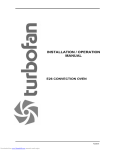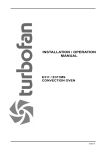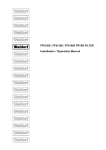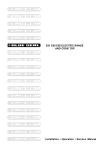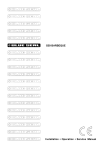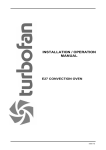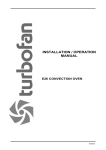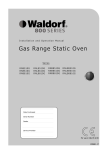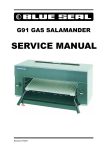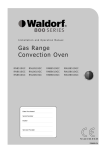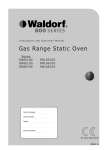Download Blue Seal G50-D Operating instructions
Transcript
G50 / G50-8 GAS RANGE MANUFACTURED BY Moffat Limited P O Box 10-001 Christchurch New Zealand Ph: (03) 3891-007 Fax: (03) 3891-276 WORLD-WIDE BRANCHES UNITED KINGDOM Blue Seal Units 6-7, Mount Street Business Park Mount Street, Nechells Birmingham B7 5 QU Ph: (121) 327-5575 Fax: (121) 327-9711 UNITED STATES Moffat Inc 3765 Champion Blvd Winston-Salem North Carolina 27115 Ph: (336) 661 0257 Fax: (336) 661 9546 CANADA Lessard Agencies Ltd P O Box 97 Stn D Toronto Ontario M6P3J5 Ph: (416) 766-2764 Fax: (416) 760-0394 NEW ZEALAND Christchurch Moffat Limited P O Box 10-001 16 Osborne Street Christchurch Ph: (03) 3891-007 Fax: (03) 3891-276 Auckland Moffat Limited 4 Waipuna Road Mt Wellington Auckland Ph: (09) 574-3150 Fax: (09) 574-3159 AUSTRALIA Victoria Moffat Pty Limited 740 Springvale Road Mulgrave, Melbourne Victoria 3171 Ph: (03) 9518-3888 Fax: (03) 9518-3838 New South Wales Moffat Pty Limited 8/142 James Ruse Drive, Rose Hill P O Box 913, Smithfield Sydney, N.S.W. 2142 Ph: (02) 8833 4111 Fax: (02) 8833 4133 Western Australia Moffat Pty Limited P O Box 689 Joondalup Business Centre WA 6027 Ph: (09) 305-8855 Fax: (09) 308-8838 Queensland Moffat Pty Limited 30 Prosperity Place Geebung, Brisbane Queensland 4034 Ph: (07) 3215-9155 Fax (07) 3215-9170 South Australia Moffat Pty Limited Unit 3/77 Prospect Road Prospect, Adelaide South Australia 5082 Ph: (08) 8269-2633 Fax: (08) 8269-2733 BLUE SEAL GAS RANGE - G50 6 OPEN BURNER GAS RANGE - G50-8 8 OPEN BURNER GAS RANGE CONTENTS PAGE SPECIFICATION 1 INSTALLATION 6 OPERATING INSTRUCTIONS 9 CLEANING 11 MAINTENANCE 11 SERVICING INSTRUCTIONS 12 SPARE PARTS 17 Date Purchased .......................................................Serial No.................................................................. Dealer ....................................................................................................................................................... Service Agent............................................................................................................................................ F19455-13 SPECIFICATION GENERAL A heavy duty, general purpose gas range created for compact modular kitchens. It has a high option hob/griddle arrangement. The oven is provided with a piezo ignition lighted constant burning pilot, flame failure device and temperature control thermostat. The hob has Flame Failure Protection for each open burner. MODEL NUMBERS OF RANGES INCLUDED IN THIS SPECIFICATION: G50-D G50-C G50-B G50-A 6 open burners plus oven 4 open burners plus 300mm griddle plus oven 2 open burners plus 600mm griddle plus oven 900mm griddle plus oven G50-8D G50-8C G50-8B G50-8A 8 open burners plus oven 6 open burners plus 300mm griddle plus oven 4 open burners plus 600mm griddle plus oven 2 open burners plus 900mm griddle plus oven CATEGORY Type: Flue Type:A I2H , I3P HEAT INPUT (Based on GROSS Calorific Value) Natural Gas (G20) Propane Gas (G31) Pressure 10 mbar 37 mbar Open Burners -Gas Rate 5.0 kW 0.48 m³/hr 5.0 kW 0.36 Kg/hr Each 300 mm Griddle -Gas Rate 5.5 kW 0.53 m³/hr 5.5 kW 0.40 Kg/hr Oven -Gas Rate 6.0 kW 0.57 m³/hr 5.5 kW 0.40 Kg/hr Pilot -Gas Rate 115 W 0.011 m³/hr 115 W 0.008 Kg/hr -1- SPECIFICATION Model Input (G20) G50-8D G50-8C G50-8B G50-8A 46.0 kW 41.5 kW 37.0 kW 32.5 kW G50D G50C G50B G50A 36.0 kW 31.5 kW 27.0 kW 22.5 kW Gas Rate (G20) Input (G31) Gas Rate (G31) 4.41 m³/h 3.98 m³/h 3.55 m³/h 3.12 m³/h 45.5 kW 41.0 kW 36.5 kW 32.0 kW 3.25 kg/h 2.93 kg/h 2.60 kg/h 2.29 kg/h 3.45 m³/h 3.02 m³/h 2.59 m³/h 2.16 m³/h 35.5 kW 31.0 kW 26.5 kW 22.0 kW 2.54 kg/h 2.22 kg/h 1.89 kg/h 1.57 kg/h GAS PRESSURE Natural (G20) Propane (G31) Supply Pressure Burner Pressure 20 mbar (8.0” WG) 37 mbar (14.8: WG) 10 mbar (4.0" WG) 37 mbar ( 14.8" WG) INJECTOR SIZES (mm) Nat Gas (G20) Prop Gas (G31) Oven 2.80 1.50 Oven Pilot 0.32 0.23 Open Burners 1.90 1.10 Griddle Burners Griddle Pilot 2.10 0.32 1.20 0.20 OVERALL DIMENSIONS Height to Hob Height to Splashback Width Depth G50 915mm 1065mm 900mm 812mm G50-8 915 mm 1065 mm 1200 mm 812 mm OVEN INTERNAL DIMENSIONS Height Width Depth G50 430mm 665mm 660mm G50-8 430 mm 665 mm 660 mm -2- SPECIFICATION WEIGHT (NETT) Model G50D Model G50-8D 220kg 295kg GAS CONNECTION Gas connection point 3/4" BSP male thread located 75mm from RH side, 55mm from rear and 610mm from floor. -3- SPECIFICATION -4- SPECIFICATION -5- INSTALLATION It is important that this Range is installed correctly, and that the operation is correct before handing over to the user. THIS APPLIANCE MUST BE INSTALLED TO THE REQUIREMENTS OF THE APPROVED LOCAL INSTALLATION CODE AND LOCAL AUTHORITY REQUIREMENTS, COVERING GAS, FIRE AND HEALTH, AND IN ACCORDANCE WITH THE NATIONAL INSTALLATION CODES: THIS UNIT MUST BE INSTALLED BY A QUALIFIED INSTALLER. - UNITED KINGDOM (GAS SAFETY/INSTALLATION & USE) REGULATIONS 1984 & 1990 AMENDMENT BS5440 PARTS 1 & 2 INSTALLATION FLUING & VENTING i) DO NOT OBSTRUCT OR BLOCK THE APPLIANCES FLUE. ii) NEVER DIRECTLY CONNECT A VENTILATION SYSTEM TO THE APPLIANCE FLUE OUTLET. iii) INSTALLATION MUST ALLOW FOR A SUFFICIENT FLOW OF FRESH AIR FOR THE COMBUSTION AIR SUPPLY. iv) INSTALLATION MUST INCLUDE ADEQUATE VENTILATION MEANS, TO PREVENT DANGEROUS BUILD UP OF COMBUSTION PRODUCTS. A. BEFORE ASSEMBLY AND CONNECTION 1. Check the type of gas, the specified operating pressure and the oven's hourly consumption. This information is clearly stated on the data plate which is located next to oven control panel. (See Page 1). 2. Check the gas supply and characteristics for the type of gas supply line pressure and capacity. 3. Installation must allow for a sufficient flow of fresh air for the combustion air supply. Combustion air requirements: G50 G50-8 Natural Gas (G20) 35m³/hr minimum 45m³/hr minimum Propane Gas (G31) 33m³/hr minimum 42m³/hr minimum 4. Components having adjustments protected (e.g. paint sealed) by manufacturer are only allowed to be adjusted by an authorised service agent. They are not to be adjusted by the installation person. 5. The operating pressures for the respective gases are: Propane Gas (G31) Natural Gas (G20) 37 mbar (14.8" WG) 10 mbar (4.0" WG) -6- INSTALLATION There are two pressure test points available for measurement of correct appliance operating pressure. Either can be used and they are located; i) On the left hand end of the hob manifold, behind the hob control panel. ii) On the oven thermostatic gas control, behind the oven control panel. Note that the two pressure test points are found on the oven thermostatic gas control, of which the rear test point should be used in this case. One hob burner or griddle burner and the oven burner should be operating at full rate when measuring the appliances operating pressure. On PROPANE GAS the pressure is controlled by the supply pressure. On NATURAL GAS the pressure is controlled by the appliances regulator, which can be adjusted to obtain correct operating pressure. B. C. 6. A regulator is supplied with appliances for use on NATURAL GAS. (These should be fitted only by a Authorised person). 7. After uncrating the range check all the dismantled parts (legs, etc.) and "concealed" parts for transit damage. Report any damage to the carrier and dealer as soon as possible. ASSEMBLY 1. Tilt the oven onto its LH side and fit both the front leg and rear roller in the corresponding leg rings. 2. Secure each one in place with the screw attached. 3. Lift up the LH side of the oven, then fit and secure the front leg and rear roller as described in (1) and (2). 4. Check that all are in place and tightened firmly. 5. Adjust the two front feet to make the oven steady and level. GAS CONNECTION 1. Gas supply connection is 3/4” BSP male. Refer to page 3 for connection location details. 2. The 3/4" gas regulator supplied only with ovens for use on NATURAL GAS must be installed on the supply line for connection at the rear of the oven. (See Page 3). 3. Ovens for use on PROPANE do not have a regulator supplied, as the pressure is controlled by a supply regulator at the PROPANE supply tank. -7- INSTALLATION 4. It is important that adequately sized piping runs directly to the connection joint on the oven, with as few tees and elbows as possible to give maximum supply volume. 5. An accessible shut-off valve must be fitted on the supply line before the connection joint and pressure regulator. 6. A suitable joining compound which resists the breakdown action of LPG must be used on every gas line connection, unless compression fittings are used. 7. Check all connections for leakage. DO NOT USE A FLAME. (NOTE: All connections to the gas supply must be by a Licensed Gas Fitter.) D. E. LOCATION 1. It is important to have a minimum of 25mm (1") of air space at the rear and sides of the oven from combustibles surfaces. 2. It is important to have a minimum of 1100 mm top clearance above the cooking surface to a non-combustible ceiling or shelf and a minimum of 1500mm top clearance above the cooking surface to a combustible ceiling of shelf. COMMISSIONING Before leaving the new installation, check Correct connections have been made, and that the unit operates in accordance with the OPERATING INSTRUCTIONS (Page 9). NOTE: If for some reason it is not possible to get the appliance to function correctly, then contact the supplier. NOTE: Shut off the gas supply before any maintenance work is done on the appliance. It is important to relight all pilot jets after changing gas cylinders or reconnecting gas supply. -8- OPERATING INSTRUCTIONS THIS APPLIANCE IS ONLY FOR PROFESSIONAL USE AND TO BE USED BY QUALIFIED PEOPLE. NOTE: Components having adjustments protected (e.g. paint sealed) by manufacturer are only allowed to be adjusted by an authorised service agent. They are not to be adjusted by the user. If using aluminium foil in the base of the oven, ensure that it does not extend past the oven base tray to ensure correct operation of the oven. A. B. C. HOB-OPEN TOP BURNERS Flame Failure Protection is incorporated by way of a thermo-electric system for each burner which will shut off the gas supply to that burner in the event that the burner goes out, so that raw gas is not expelled. 1. Select the burner, depress and turn the corresponding knob anti-clockwise to position. 2. With control knob depressed, light burner. 3. Release knob after approximately 10-20 seconds after lighting burner. 4. Burner should stay alight - if not, repeat Steps 2-3. 5. The burner can now be operated. At this position it is FULL. 6. To achieve simmer control, depress knob and rotate fully anti-clockwise. Or operate between FULL and LOW positions. 7. When main burner is not required, turn knob clockwise back to OFF position. GRIDDLES 1. Depressed control knob and rotate anti-clockwise to PILOT position. 2. With the control knob depressed press Piezo button to ignite pilot burner. Repeat until lit. 3. Release knob approximately 10 seconds after lighting pilot. 4. Pilot should now remain alight - if not, repeat Steps 2 to 4. 5. Full flame can now be achieved by rotating control anti-clockwise to first stop. 6. Low flame can be achieved by depressing the control and rotating fully anticlockwise. OVEN 1. Open oven doors. Push in thermostat knob and rotate anti-clockwise to PILOT position. -9- OPERATING INSTRUCTIONS 2. Hold in thermostat knob. 3. With the thermostat knob held in press Piezo button to ignite pilot burner. Repeat until lit. View the lit burner through the inspection hole. 4. Release knob approximately 10 seconds after lighting pilot. 5. Pilot should now remain alight - if not, repeat Steps 2 to 4. 6. The oven temperature can now be set by rotating the control knob anticlockwise to any position from the 1 - 7 markings. The control knob requires to be slightly depressed when starting from the pilot position, however once out of the pilot position it can be freely turned up or down. See the temperature conversion chart below for oven centre temperatures obtained at the gas mark settings 1 - 7. 7. If preheating the oven is required, set thermostat knob to position 4 (approx. oven centre temperature 200 °C) and allow 20 minutes before cooking in the oven. 8. To turn the oven off to pilot only, rotate the knob clockwise until the pilot position is reached. In this position only the pilot burner will remain on. 9. To turn the oven completely OFF, slightly depress the control knob from the pilot position and rotate clockwise until OFF position is reached. The pilot burner will be shutdown and the gas valve closed. To relight oven refer to step 1. GAS MARK TEMPERATURE CONVERSIONS The oven thermostat control knob is marked 1 to 7. The thermostat can be set anywhere within this range and will thermostatically maintain oven temperature. The following chart indicates approximate oven centre temperatures that will be maintained at the knob markings. GAS MARK 1 100 2 130 3 160 4 190 5 225 6 260 7 290 TEMPERATURE °C Temperatures required between the above should be obtained by setting the control between the markings. -10- CLEANING & MAINTENANCE CLEANING THE GAS SUPPLY MUST BE OFF DURING CLEANING OR MAINTENANCE. EXTERIOR Clean with detergent. Baked on deposits or discolouration may require a good quality stainless steel cleaner or stainless steel wool. Always apply cleaner when the range is cool and rub in the direction of the "grain". INTERIOR Do not use wire brushes, steel wool or other abrasive materials. Clean the oven regularly with a good quality domestic oven cleaner. Once a week, remove and clean built up grease etc. from the oven racks and bottom spill over cover. MAINTENANCE To achieve the best results cleaning must be regular and thorough and all controls and mechanical parts checked and adjusted periodically by a competent serviceman. If any small faults occur, have them attended to promptly. Don't wait until they cause complete breakdown. It is recommended that a service check is conducted every six months. -11- SERVICING INSTRUCTIONS NOTE: Components having adjustments protected (e.g. paint sealed) by manufacturer are only allowed to be adjusted by an authorised service agent. They are not to be adjusted by an unauthorised service person. OVEN A. BURNER AIR ADJUSTMENT All gas adjustments should be done by a Qualified Person. The hob open top, griddle and oven burners can all be adjusted to give the most efficient flame. This is done by adjusting the aeration slides through which air is drawn in with the injected gas. The most efficient flame is clear blue/green in colour. If the flame is yellow and wavey, then the burner needs adjusting. B. OVEN CONTROL The thermostat valve used in this oven to control the oven burner and maintain set temperature, also controls the oven pilot burner and flame failure protection. The control has a combination modulating/snap action thermostat, allowing the burner flame size to increase/decrease according to heat demand and to avoid overshoot, and be shut off the burner when responding to rapid temperature change requirements. The thermostat is factory set and cannot be calibrated. However should the oven temperature need checking, the following steps should be taken. 1. Place an accurate thermometer or thermocouple in the centre of the oven. 2. Ignite oven pilot as per operating instructions. 3. Turn the thermostat knob to setting 4. 4. Wait for the oven temperature to stabilise (approximately 20 minutes). 5. Oven centre temperature should be 200 °C ± 10 °C. Should a problem exist, the following checks should be made before assuming the thermostatic control is faulty. a. b. c. d. Check burner pressure. Check MAXIMUM flow adjustment setting on control valve. Check MINIMUM flow adjustment setting on control valve. Pilot burner rate adjustment Refer to page 13 for a, b, c & d procedures. -12- SERVICING INSTRUCTIONS OVEN BURNER PRESSURE To check oven burner pressure, fit a pressure gauge to the front pressure test point on the oven thermostatic gas control located behind the oven control panel. The oven burner pressures should be measured with the oven burner operating: a) At maximum flow setting (refer oven maximum flow setting). b) At minimum flow setting (refer oven minimum flow setting). To check correct appliance operating pressure and/or supply pressures refer to installation section. OVEN MAXIMUM FLOW SETTING The maximum flow setting on the oven control is factory set on the oven control is factory set and sealed. It should not be necessary to adjust at any stage. However, if a control is being replaced and correct operation is required to be verified, the following check should be made; With the pilot burner lit, the oven burner pressure should be as listed below when measured with the burner operating at maximum rate.(Set control knob to position 7). NATURAL (G20) -8.7 mbar ± 1.0 (3.5” WG ±0.2”) PROPANE (G31) -35 mbar ± 1.0 (14” WG ±0.4”) The maximum flow rate adjuster screw is located on the underside of the control and should always be two (2) turns out and sealed. DO NOT unscrew more than two turns. OVEN MINIMUM FLOW SETTING The minimum flow setting is important to ensure good temperature control of the oven. The minimum flow setting on the oven control is factory set and sealed. It should not be necessary to adjust at any stage. However, if a control is being replaced and correct operation is required to be verified, the following check should be made; With the pilot burner lit set oven control knob to position 7. Measure the oven burner pressure as described above, then turn the control knob back until just before the thermostat control snap-action turns the burner off. The burner should now be operating at the minimum flow rate. The burner pressure at this rate should be as follows. NATURAL (G20) -3.7 mbar ± 0.5 (1.5” WG ±0.2”) PROPANE (G31) -7.5 mbar ± 1.0 (3.0” WG ±0.2”) -13- SERVICING INSTRUCTIONS The minimum flow rate adjuster screw is located at the left hand bottom corner on the front of the control. This screw should always be paint sealed. PILOT FLAME SETTING The pilot flame adjusting screw should always be fully open and is factory set and sealed in this state. Field adjustment should not be necessary unless replacing the control. Correct setting is achieved by fully screwing in the adjustment screw, located at the top right of the gas control front face, then unscrewing anticlockwise 3 full turns. Check the pilot flame operation and paint seal adjusting screw. PIEZO IGNITION To repair or replace, firstly check as described in "C" for Griddle, below. C. PILOT BURNERS AND PIEZO IGNITION FOR GRIDDLE AND OVEN PIEZO IGNITION Should there be a fault with the piezo ignition system employed to ignite the pilot burner, carry out the following: 1. If spark is being generated but not sparking from ignition electrode to pilot burner hood; a. b. 2. Check H.T. lead and connections. Replace or repair. Check ignition electrode is not cracked and is positively positioned. Replace or repair. If piezo igniter is faulty, remove from control panel and replace. PILOT BURNER/THERMOCOUPLE If pilot burner is not burning correctly check pilot orifice is not blocked and pilot is clear. Clear and replace pilot orifice if necessary. If pilot burner goes out check the following: 1. Pilot burner is not blocked. Clean or replace pilot orifice. 2. Thermocouple connection to gas control is firm. Tighten if necessary. 3. Thermocouple is in working order. Should generate between 20-30mV. Replace if faulty or suspect. Electromagnet in rear of gas control is in good working order. Inspect and replace if necessary. 4. -14- SERVICING INSTRUCTIONS D. GRIDDLE MAIN BURNER To replace unscrew 3/16" screw at rear of burner and remove. Refit new burner. GAS CONTROL - Servicing To regrease gas control, remove control knobs and control panel. Remove 2 screws holding shaft plate to gas control body and remove control shaft and plate. Note orientation of shaft for correct re-assembly. Using needle nose pliers or similar, pull out gas control spool, again noting orientation. Using suitable compound rated for use with Natural and LP gases and high temperature rating, re-grease spool. Re-assemble by reversing procedure. GAS CONTROL - Replacement 1. Remove fat collection trays. 2. Remove griddle plate. 3. Remove knobs and control panel. Disconnect piezo H.T. lead from piezo igniter. 4. Remove securing nuts and washers from rear of each burner. Remove burner(s). 5. Unclip and remove front reflector plate from main griddle reflector panel. 6. Slide reflector panel forward and lift away from rear. 7. Undo pilot supply and disconnect pilot thermocouple from gas control. 8. Using 19 mm spanner, undo compression nut securing gas control to manifold assembly. Re-assemble in reverse order and check for gas leaks with soapy water. -15- SERVICING INSTRUCTIONS E. OPEN BURNERS GAS CONTROL - Servicing To regrease gas control follow same procedure as in C for griddle gas controls. GAS CONTROL - Replacement To replace gas control follow same procedure as in C for griddle gas controls. THERMOCOUPLE Should the open burner not remain alight when the control knob is released after ignition, it is likely that the thermo-electric flame failure system has a fault. However, always remember to check burner operation and ignition procedures as found in OPERATING SECTION are being correctly followed before servicing. If a fault does exist, the following should be checked and rectified where necessary. 1. Inspect thermocouple for foreign build up on tip. This could be in the form of carbon or food deposits. Clean off any deposits taking care not to scratch off aluminium coating on thermocouple tip. 2. Remove enamelled pot-stand/trivet and check thermocouple connection to gas control. Connection nut should be hand tight, then a quarter turn with 10 mm spanner. 3. Check thermocouple tip is in the flame zone of the burner; ie when the burner is lit, the flame should impinge on the top 5 mm of the thermocouple tip. The thermocouple should not touch the burner. If the thermocouple is not correctly positioned, check the thermocouple nut is secure in mounting bracket. If the thermocouple is to low, loosen securing nut, push thermocouple fully up into bush on mounting bracket and retighten securing nut. 4. If 1-3 are correct, but burner will still not remain alight, disconnect thermocouple and using a DC millivolts multimeter. Test thermocouple for thermocouple for millivolts output with burner alight. Thermocouple should produce 20-30 millivolts. Replace thermocouple if faulty. 5. If thermocouple produces the correct voltage, remove the aluminium nut off the rear of the gas control and remove electro-magnet. Inspect and test operation on thermocouple. Replace if necessary. -16- SPARE PARTS RANGE G50, G50-8 Part No HOB Description Open Burners 004573 004574 004618 037190 037110 019430 019428 019429 019371 Burner Front Burner Rear Burner Cap Injector (NATURAL) Ø 1.90 mm Injector (PROPANE) Ø 1.10 mm Gas Control Thermocouple - Front M9 x 320 mm UNIFIED Thermocouple - Rear M9 x 850 mm UNIFIED Pressure Test Point Griddle 014105 034210 034130 017800 019215K 018692 018693 019428 016320 018095 016385 016386 016387 Burner Injector (NATURAL) Ø 2.10mm Injector (PROPANE) Ø 1.20mm Gas Control Pilot Burner Pilot Orifice (PROPANE) Ø 0.20 mm Pilot Orifice (NATURAL) Ø 0.32 mm Thermocouple Piezo Igniter Piezo H.T Lead Griddle 300mm Griddle 600mm Griddle 900mm -17- SPARE PARTS RANGE G50, G50-8 Part No Description Oven 012248 018691K 020253 032280 032150 019217 018693 019406K 016320 018695 022407 022408 Oven Burner Oven Pilot Oven Thermocouple Oven Burner Injector (NATURAL) Ø 2.80 mm Oven Burner Injector (PROPANE) Ø 1.50 mm Pilot Orifice (PROPANE) Ø 0.23 mm Pilot Orifice (NATURAL) Ø 0.32 mm Gas Control Thermostat Kit Piezo Ignitor Piezo H.T Lead Low fire screw - (PROPANE) 0.95 mm Low fire screw - (NATURAL) 1.5 mm General 004125 016659 013634 004158 019435 019436 011853 004333 004334 013243 013244 011005 010254 018031 018081K Pot Stand/Trivet Pot Stand Spider Hot Top (Cast Iron) Hob Spillage Tray Knob - Open Burner (FRONT & GRIDDLE) Knob - Open Burner (REAR) Regulator 3/4" - (Natural Gas only) Door Inner Panel - Enamelled LH Door Inner Panel - Enamelled RH Door Outer Panel - RH Door Outer Panel - LH Ball Catch Striker Plate Handle Tube Handle End Cap -18-

























